31% one-season increase in box office gross from pricing strategy
The situation
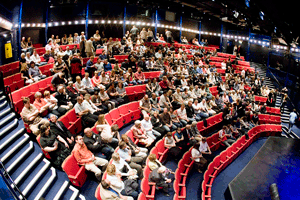
|
Photo by Mike Kwasniak.
|
In 2014, the New Wolsey Theatre was re-examining its financial picture, focusing on its earned vs. contributed income streams. Like many theatres in the United Kingdom, government funding still accounted for a significant proportion of their revenue. Over the three years prior, they had received moderate funding cuts totaling approximately £50,000 (around $79,000 U.S.).
Located in Ipswich, Great Britain, the midsized regional theatre produces a spring and autumn season, as well as a Christmas show, with a mixture of both home produced and touring product. Many of the productions were selling well, which left Head of Sales and Marketing Stephen Skrypec wondering what the theatre could do to grow earned income.
Stephen: We’d become as efficient as we could in the rest of the business; the only place to reduce spending was in artistic and we really didn’t want to do that. For earned revenue, I had done standard things I felt I could do—making sure there were more tickets available at the top price and making sure every single seat was sold when it could be sold. I’d gotten to the point where I’d done all I thought I could do to maximize revenue. What do I do now?
New Wolsey Theatre brought on TRG Arts in August 2014 for a Demand Management Sprint.
Stephen: TRG seemed to have a passion for testing the norm. I started watching the webinars and using ideas I had learned and thought, there’s something massively important here that we’re not doing in the U.K.
TRG and New Wolsey Theatre did an initial data analysis and made the following observations:
The “Double Donut”
The New Wolsey Theatre has a thrust stage with a seating capacity of 400. The venue looked evenly filled when a performance was well-sold, but when the performance didn’t sell well, there were many visible empty seats.
Stephen: We wanted to reverse the ‘double donut’ situation we had going on in our premium seats. We’d created that ourselves by changing price points to maximize revenue in a high-demand situation. In performances without demand, it created some weird shapes in the fill pattern.
Heat Map for Low-Sold Performances

The “double donut”: two areas of the house typically remained empty for low-sold performances,
while the surrounding seatswere filled. (This heat map shows how frequently seats are filled.
Each box represents a seat. The darker the box, the more frequently the seat is filled.)
Demand was greater for seats in the center of the premium section and in Band A seats closest to the center, leaving the edges of the premium section empty. Row L, the very back row, was also popular because it was priced at Band B.
New Wolsey Theatre's Former Scale Plan
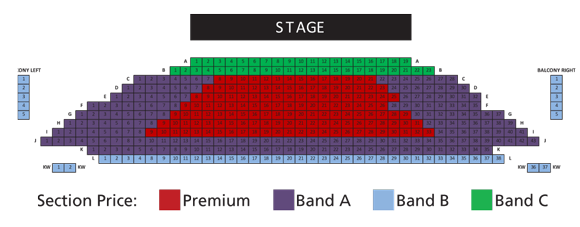
A culture of discounts
As in the U.S. and Canada, the U.K. has a culture of offering discounts to children and people over age 60. New Wolsey Theatre’s discount, or concession, policy allowed people in these groups lower priced tickets as a way to keep ticket prices accessible. For some shows, discounted tickets made up more than 40% of New Wolsey Theatre’s audience.
Stephen: We were terrified about customer impact of changing the concession policy or raising prices. This was a very important part of our audience base. At the same time, we’d held prices the same for five years and we couldn’t go on doing that in the situation of public funding we were in.
Opinion-based pricing
New Wolsey Theatre had a peak/off-peak pricing strategy, meaning they offered different prices based on time of day, day of week, or genre of performance. For performances that were expected to be high in demand, the theatre offered higher base prices. For performances that were expected to have less box office draw, the theatre offered lower base prices.
Stephen: We were pricing the product based on our opinion of its value. We had high, mid, and low pricing structures. We put musicals and events that we thought would sell well in the high pricing table. We would put things we didn’t think we could sell tickets to at £25 [about $40 U.S.] for the middle. We put things in the low pricing table we didn’t think would sell well.
The Results
In just nine months, New Wolsey Theatre implemented the changes and began to see growth in revenue. Comparing the Spring 2014 season to the Spring 2015 season, their results included:
- 31.5% increase in box office gross from £329,000 to £433,000– a massive £100,000 ($157,000 U.S.) year over year increase
- 31.5% increase in per capita/average price paid from £10.19 to £13.40
Additionally, there was a:
- 24.4% increase in customers seeing 4 or more shows
- 69.2% increase in customers seeing 8 or more shows
Dynamic pricing had a substantial impact. Below is a comparison of two one-week touring drama shows that sold a similar number of tickets.
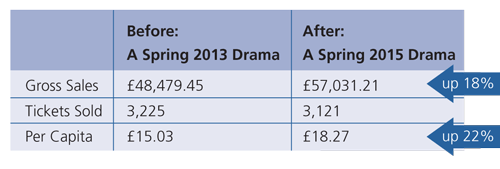
How they did it
“We’re really popular.”
The consultants set out to combat the “double donut” problem with a new scale of hall plan combined with a hold-and-release plan. The two strategies work together to increase the audience’s perception of success. The scale was designed to ensure the house filled from front to back so there would be no large swaths of empty seats in highly visible areas. The hold-and-release plan held off sale the seats further back in the theatre until a certain number of seats further forward had sold.
Based on TRG recommendations, New Wolsey Theatre stopped pricing the back row at the lowest price and priced it at the second tier price point.
Stephen: We had a “back row brigade” who were accustomed to always buying in the back row. They now needed to buy elsewhere if they wanted the cheapest seats, because all of the lowest-priced tickets were further forward in the house, and the back row tickets didn’t go on sale right away anymore. The feedback and understanding of these changes has been very encouraging. It has given us the opportunity to develop a closer relationship with customers that were visiting regularly and booking very specific seats.
The theatre converted their peak/off-peak pricing strategy to dynamic pricing. This caused minimal customer impact, but has resulted in the large increases in gross and per capita sales mentioned above.
Stephen: Most people who are booking at the end of the sales cycle don’t know their ticket has been dynamically changed. The only people that do are the very small percentage of people who have studied the brochure, where we are clear to say that prices are “starting at.” The message becomes, “Book early, because we’re really popular.”
A low-mid sold house
at New Wolsey Theatre
|
Before:
 |
After
 |
| (Gray dots represent filled seats) |
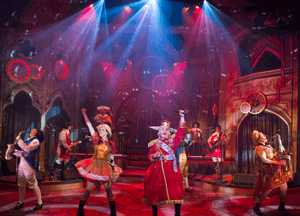
|
Lilly Howard, Sarah Mahony, Sean Kingsley
and Esther Biddle in Sleeping Beauty.
Photo by Mike Kwasniak.
|
The great £1.50 leap
New Wolsey Theatre needed to make changes to pricing in order to optimize revenue. One of the ways they did that was by raising the price on the lowest priced tickets from £8.50 to £10. Preserving accessible prices was important.
“We’re obsessed with accessible pricing,” Stephen said. “That increase felt big to us, but it hasn’t had any negative impact.”
The modest increase allowed the theatre to standardize the low price point for every performance. Regardless of the popularity of the performance, there were always 40 tickets at £10.
Low-priced tickets also supported loyalty at New Wolsey Theatre. TRG and New Wolsey Theatre re-priced the season ticket packages and re-positioned to promote the value of subscribing.
Stephen: A lot of people who were engaging for every show in the season were the ones buying £10 tickets. It’s actually cheaper for them if they book a season ticket at our second price point. Now we have the leverage to move them out of buying multiple £10 tickets and into season tickets. That also means that more £10 single tickets can be accessible to more casual theatregoer for a longer period of time in the sales cycle.
Accessible prices, sustainable practices
New Wolsey Theatre also made the difficult decision to stop offering entitlement concessions, like the over-60 discount. They kept an under-26 ticket at a flat rate of £10 to continue to encourage audience development in this under represented age group.
Stephen: We agonized over the decision to remove concessions. I knew we needed to do it, but I was really scared of the customer impact. We had fears that massive amounts of people would complain. TRG changed our thought process about how to have that conversation. It was like letting go of a massive balloon.
We were prepared for a substantial process of explaining these changes but our customers understood and supported our decision because we were able to explain clearly our rationale and also promote the range of prices on offer. From the first step of this process we were committed to being honest, clear and transparent with our customers.
The Reaction
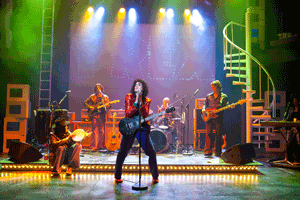
|
George Maguire and T.Rex in 20th Century Boy
Photo by Mike Kwasniak.
|
Stephen: Working with TRG gave us the courage to make these changes which have had substantial impact to our financial stability. Having a trusted outside partner who has done this many times helped us have confidence in our decisions when we weren’t sure how patrons would react. TRG also wasn’t afraid to call us out when we needed to be gently pushed.
I can’t believe the journey we’ve taken. We’ve changed the way we budget our marketing, the way we price, the structure of our team... It’s a fundamental shift in the way we do business. We’re also a more attractive venue in the touring market. Now we’re working on retention, building season ticket holders, and building the potential for philanthropy. And, we’re making successful shows even more successful, which is a boost to the entire team. It started out as just a seat map, but it’s been so much more.
With the working capital generated from the pricing adjustments, New Wolsey Theatre is now investing in increasing the number of tickets sold. The story continues…
About New Wolsey Theatre Company
The New Wolsey Theatre is a producing theatre, located in Ipswich, Suffolk in the United Kingdom. Founded in 2001, it aims to create, develop and produce a vital and dynamic program of theatre, and other live performances and projects. The theatre has emerged as a national leader, recognized for the diversity of its audiences; for engaging with a broad cross-section of theatre-going and non-theatre-going communities. The New Wolsey Theatre is currently prioritizing accessibility for deaf and disabled artists, participants and audience members. Find out more at wolseytheatre.co.uk.

|
Lindsay Anderson
VP of Client Development
TRG Arts |
At The New Wolsey Theatre in the UK, small changes to pricing strategy resulted in big revenue increases. In just nine months, the company reported a 31% increase in box office gross—without selling more tickets. In this free webinar, New Wolsey’s former Head of Sales and Marketing Stephen Skrypec and TRG’s VP of Client Development Lindsay Anderson will share how the theatre updated daily practices and challenged prior assumptions about audiences, leading to their success. We’ll examine how arts organizations, whether in the US, UK, or elsewhere, can use pricing to drive patron behavior and revenue.
Watch the webinar recording>>
Download this case study
To download a PDF of this case study, complete the form below: